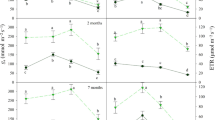Abstract
The phenology and leaf traits ofDaphne kamtschatica Maxim. var.jezoensis (Maxim.) Ohwi, the only summer deciduous shrub (20–40 cm) in the temperate forest of northern Japan, are examined. This plant carries through the winter mature leaves and well formed flower buds. It flowers in early spring during snowmelt and begins photosynthesis under relatively high irradiance under an open forest canopy. Our results show that there is significant carbon gain during the period when new leaves and fruit maturation also take place. Beginning in June, as the forest canopy closes, leaves onDaphne shoots senesce acropetally and the plants become completely bare in mid-July. After a period of 20-day dormancy, the shoots begin to resprout. Leaves become mature in early October and remain on the stem over winter. Leaf traits and photosynthesis measurements suggest as follows. 1) By becoming summer deciduous,D. kamtschatica avoids the cost of maintaining leaves inefficient under deep shade. 2) The onset and breaking of the summer dormancy is triggered by photoperiod since plants at the forest edge also become dormant even when light remained relatively high. However, the decreased duration of dormancy with higher light levels suggests that there is a tendency towards shorter dormancy where summer shade is absent and this could eventually lead to an evergreen habit such as that found in the alpine speciesDaphne miyabeana.
Similar content being viewed by others
References
Barnes, J.D., Balaguer, L., Manrique, E., Elvira, S. andDavison, A.W. 1992. A reappraisal of the use of DMSO for the extraction and determination of chlorphylls in lichens and higher plants. Environ. Exp. Bot.32: 85–100.
Björkman, O. 1981. Responses to different quantum flux densities.In O.L. Lange, P.S. Nobel, C.B. Osmond, and H. Ziegler, eds., Encyclopedia of Plant Physiology, vol. 12A. Plant Physiological Ecology 1, Springer-Verlag, Berlin, pp. 57–107.
Chabot, B.F. andHick, D.J. 1982. The ecology of leaf life spans. Annu. Rev. Ecol. Syst.13: 229–259.
Chazdon, R.L. 1988. Sunflecks and their importance to forest understory plants. Adv. Ecol. Res.18: 1–63.
dePamphilis, C.W. andNeufeld, H.S. 1989. Phenology and ecophysiology ofAesculus sylvatica, a vernal understory tree. Can. J. Bot.67: 2161–2167.
Horn, H.S. 1971. The Adaptive Geometry of Trees. Princeton University, Princeton, New Jersey.
Hughes J.W. 1992. Effect of removal of co-occurring species on distribution and abundance ofErythronium americanum (Liliaceae), a spring ephemeral. Amer. J. Bot.79: 1329–1336.
Ishizuka, M., andSugawara, S. 1989.Composition and structure of natural mixed forests in central Hokkaido II. Effect of disturbances on the forest vegetation paterns along the topographic moisture gradients. J. Jpn. For. Sci.71: 89–98.
Kikuzawa, K. 1984. Leaf survival of woody plants in decidous broad-leaved forests. 2. Small trees and shrubs. Can. J. Bot.62: 2551–2556.
Kikuzawa, K. 1991. A cost-benefit analysis of leaf habit and leaf longevity of trees and their geographical patern. Am. Nat.138: 1250–1263.
Koike, T. 1988. Leaf structure and photosynthetic performance as related to the forest succession of deciduous broad-leaved trees. Plant Sp. Biol.3: 77–87.
Koike, T. 1991. Autumn coloring, photosynthetic performance and leaf development of deciduous broadleaved trees in relation to forest succession. Tree Physiology7: 21–32.
Koike, T., Tabuchi, R., Takahashi, K. andLei, T.T. 1998. Characteristics of the light response in seedlings and saplings of ash and kalopanax, mid-successional species, during early stages of regeneration in a mature forest. J. Sust. For.6: 73–84.
Küppers, M. 1985. Carbon relations and competition between woody species in a Central European hedgerow. IV. Growth form and partitioning. Oecologia66: 343–352.
Lawrence, G.H.M. 1951. Taxonomy of Vascular Plants. Macmillan, New York.
Lei, T.T. and Koike, T. 1998. Functional leaf phenotypes for shaded and open environments of a dominant dwarf bamboo (Sasa senanensis) in northern Japan. Int. J. Plant Sci. (in press).
Lei, T.T., Tabuchi, R., Kitao, M., Takahashi, K. andKoike, T. 1998. Effects of season, weather and vertical position on the variation in light quantity and quality in a Japanese deciduous broadleaf forest. J. Sust. For.6: 35–55.
Mahall, B.E. andBormann, F.H. 1978. A quantitative description of the vegetative phenology of herbs in a northern hardwood forest of Hubbard Brook Experimental Forest, West Thornton, New Hampshire. Bot. Gaz.139: 467–481.
Ohwi, J. 1965. Flora of Japan. Smithsonian Institution, Washington, D.C.
Pearcy, R.W. 1983. The light environment and growth of C3 and C4 tree species in the understorey of a Hawaiian forest. Oecologia58: 19–25.
Polunin, O. 1969. Flowers of Europe: a Field Guide. Oxford University, London.
Polunin, O. 1980. Flowers of Greece and the Balkans: a Field Guide. Oxford University, London.
Polunin, O. 1985. Flowers of the Himalaya, Oxford Press, Delhi.
Reich, P.B., Walter, M.B. andEllsworth, D.S. 1992. Leaf life-spain in relation to leaf, plant, and stand characteristics among diverse ecosystems. Ecol. Monogr.62: 365–392.
Reich, P.B. 1995. Phenology of tropical forests: patterns, causes, and consequences. Can. J. Bot.73: 164–174.
Sparling, J.H. 1967. Assimilation rates of some woodland herbs in Ontario. Bot. Gaz.128: 160–168.
Taylor, R.J. andPearcy, R.W. 1976. Seasonal patterns of the CO2 exchange characteristics of understory plants from a deciduous forest. Can. J. Bot.54: 1094–1103.
Author information
Authors and Affiliations
Rights and permissions
About this article
Cite this article
Lei, T.T., Koike, T. Some observations of phenology and ecophysiology ofDaphne kamtschatica Maxim.var.jezoensis (Maxim.) Ohwi, a shade deciduous shrub, in the forest of northern Japan. J. Plant Res. 111, 207–212 (1998). https://doi.org/10.1007/BF02512171
Received:
Accepted:
Issue Date:
DOI: https://doi.org/10.1007/BF02512171




